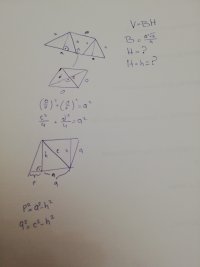The base of an oblique prism is an equilateral triangle of side a, one side is normal to the base and has the shape of a rhombus with a smaller diagonal c. Calculate the volume.
After some thinking I have visualized this problem. Basically one side goes from a square to a rhombus and that's how it has 90 degrees to the base. At least that's how I understood. The answer has to include only a and c and so far the only thing I am missing is H, height of the prism, which is also h, height of the rhombus. So If I am right the question is basically, how to calculate rhombus height with a side and a smaller diagonal?
Help

After some thinking I have visualized this problem. Basically one side goes from a square to a rhombus and that's how it has 90 degrees to the base. At least that's how I understood. The answer has to include only a and c and so far the only thing I am missing is H, height of the prism, which is also h, height of the rhombus. So If I am right the question is basically, how to calculate rhombus height with a side and a smaller diagonal?
Help

